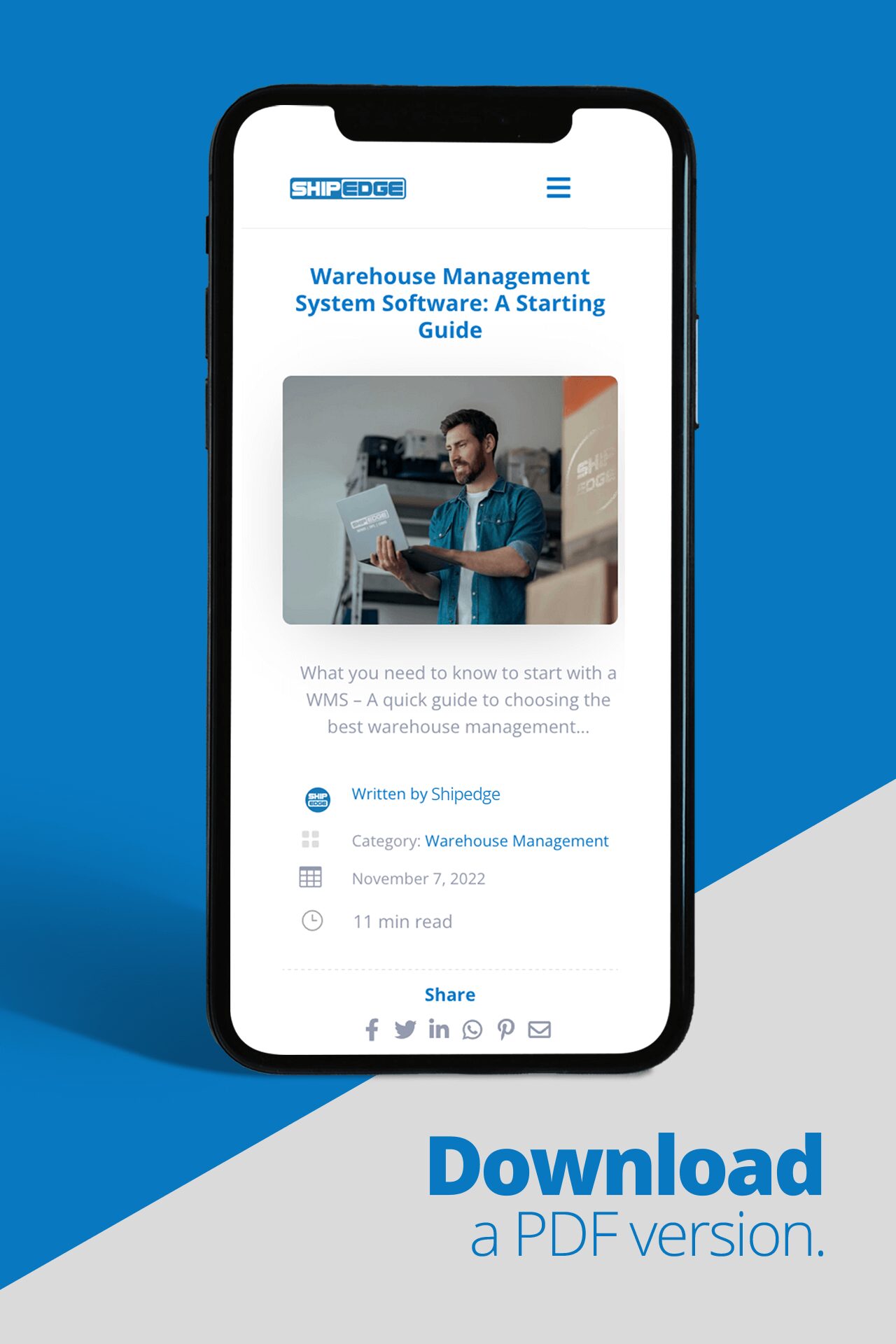Efficient inventory management lies at the core of a thriving business. It’s not just about having the right products in stock. It’s about understanding the financial implications of holding inventory in your warehouse. Inventory carrying costs are the economic bedrock upon which a successful inventory management strategy is built.
They reveal essential insights into the efficiency of your operations, and when managed effectively, they can lead to cost savings and increased profitability.
This article will explore the significance of calculating inventory carrying costs, examining why they matter beyond the financial aspect. We’ll delve into the various expenses associated with maintaining excessive inventory levels, showcasing how they can impact your business’s financial health and overall operational efficiency. Furthermore, we will discuss strategies for reducing these costs, focusing on innovative solutions like Shipedge Warehouse Management Software (WMS).
What is the Cost of Holding Inventory in a Warehouse?
Inventory carrying costs are the financial costs of holding inventory in a warehouse.
These costs include the cost of storage space, insurance, and labor.
Inventory carrying costs are a vital measure in evaluating the efficiency of your operations. Elevated moving expenses may indicate an excess of inventory relative to demand, necessitating adjustments to order frequency from manufacturers or distributors or an opportunity to enhance stock turnover.
For example:
- A company with high inventory carrying costs may order too much list or hold stock for too long. This can lead to several problems, such as cash flow problems, obsolescence, and damage.
Companies can enhance their profitability and achieve tremendous financial success by reducing inventory carrying costs with the help of some tools like, for example, Shipedge Warehouse Management Software. This article will present you with some critical questions about inventory carrying costs. We will also explain how our WMS can help you control warehouse-taking costs.
Discover how our WMS can improve your business
Why is it Important to Calculate Inventory Carrying Costs?
Since holding costs can constitute a significant portion of total inventory expenditures, they wield substantial influence over a company’s overall financial well-being. Without the ability to quantify the expenses tied to maintaining inventory, achieved through implementing an inventory or stock control system, a business may encounter cash flow challenges.
Moreover, an enterprise might unknowingly forego attractive investment and growth opportunities when excessive capital is tied up in inventory, all due to a lack of awareness regarding the hindrance of carrying costs.
There are additional reasons why holding costs carries significance:
- Production Planning: When a company comprehends its expenditure on inventory storage, it can reevaluate its production timetable. For instance, the company may maintain minimal stock if a particular product can be produced swiftly. Conversely, an item with high demand and low carrying costs might warrant allocating more warehouse space. Employing a Material Requirements Planning (MRP) process can offer valuable insights.
- Profitability analysis of existing inventory: Through the calculation of inventory carrying costs and meticulous tracking of each product’s value, an organization can more accurately project the profits it can derive from its existing inventory. Given that carrying costs are a substantial inventory expense, this information facilitates a clearer assessment of item-specific profitability.
- Inventory accounting: Inventory ranks among the most significant expenditures for many businesses, necessitating precise calculations of the costs associated with holding inventory and the value of the products. The accounting team relies on this data to produce precise financial statements.
READ MORE: Strategies for Managing Perishable Inventory in Warehousing
What are the Costs Associated with Holding Excess Levels of Inventory?
The following sections will explore the various costs of maintaining excessive inventory levels. Understanding these expenses is crucial for businesses seeking to optimize inventory management strategies and enhance their financial health. We will explore the impact of excess inventory on carrying costs, storage expenses, and more.
1 – Security
Warehouses often house valuable and appealing inventory items, making them susceptible to significant annual losses due to theft, thereby inflating storage costs. Conversely, some warehouses might not harbor high-value items but could still face internal pilferage, particularly of small tools. To mitigate these risks, warehouse managers can consider implementing the following measures:
- Restrict access to authorized personnel, limiting entry to warehouse staff only.
- Secure the premises by locking buildings when not in use and, if necessary, hiring security personnel.
- Implement rigorous checks for all incoming goods, ensuring accuracy of quantity, weight, and specifications.
- Establish robust systems for stock-checking and auditing.
- Enforce strict authorization procedures for item issuance, requiring proper signatures and authorization on requisitions.
- Maintain meticulous inventory records, documenting all incoming and outgoing items to detect discrepancies promptly.
Safeguarding warehouses against theft and pilferage is crucial, whether housing valuable or less expensive items. Implementing security measures, like installing security cameras or hiring security guards, stringent checks, and meticulous record-keeping, protects inventory and contributes to more efficient and cost-effective warehouse management.

2 – Insurance
Inventory should be protected through insurance coverage against potential hazards such as fire, theft, or damage. The amount of goods stored in inventory directly influences insurance costs for warehouse coverage, with higher stock values leading to higher premiums for loss or damage protection. Typically, as inventory value rises, insurance premiums also rise, and conversely, they decrease as inventory values decrease.
3 – Spaced Used
The quantity of inventory on hand directly impacts the space needed within the storage facility.
By reducing excess stock to a reasonable minimum, the warehouse’s size can be minimized.
Efficient space utilization serves as a gauge of stores’ effectiveness. A largely vacant warehouse results in wasteful expenses like rent, utilities, labor, and equipment costs. To optimize finances, it’s essential to maintain an appropriately filled warehouse that aligns with the organization’s service requirements. It’s important to emphasize that this doesn’t imply overfilling the warehouse. If it’s too spacious, it incurs unnecessary costs. In such cases, consideration should be given to repurposing or leasing the surplus space for external temporary storage needs.
Striking the right balance in warehouse space utilization is essential to optimize operational efficiency and minimize unnecessary costs, ensuring that storage facilities serve the organization’s needs effectively.
4 – Damaged Goods
Mishandling of stocked items can result in damage, particularly affecting fragile goods like glass, but even robust materials such as steel may become distorted when mishandled. Even seemingly durable items like concrete blocks can incur chips from accidents.
Such damage renders items unusable, necessitating replacement at an additional cost to the organization, effectively writing off the money spent. Moreover, the potential resale value to other users diminishes significantly, with only a fraction recouped through scrap sales. Insurance can serve as a mitigating factor.
To reduce stock damage occurrences, consider implementing the following measures:
- Conduct meticulous inspections of incoming stock to identify and address damaged or inadequately packaged items for protection.
- Adhere to a “first in, first out” (FIFO) usage approach to ensure stock rotation.
- Maintain appropriate environmental conditions, such as temperature and humidity, tailored to the specific stock type.
- Provide training for all staff on handling equipment usage and stress the importance of careful stock handling.
Minimizing stock damage is crucial to prevent unnecessary costs and waste, and it can be achieved through diligent inspection, proper handling, and suitable storage conditions, ultimately preserving the value of inventory for the organization.
READ MORE: Strategies for Managing Perishable Inventory in Warehousing
5 – Depreciation
Certain items or materials in storage may undergo deterioration over time, leading to undesirable outcomes:
- Paper may discolor
- Iron and steel items can develop rust
- Technology may become obsolete
Similar to damage, deterioration escalates storage expenses because affected items lose their utility. Replacement costs are incurred for deteriorated items, although some may find value in selling them for scrap, mitigating these expenses. Insurance can also serve as a safeguard against such losses.
To minimize the risk of deterioration, reducing stock levels can be effective.
However, a more proactive approach involves storing susceptible goods in appropriate conditions, such as keeping moisture-sensitive materials in dry environments.
6 – Fraud
Fraudulent activities can occur when a staff member attempts to gain unauthorized personal benefits or conceals inefficiencies, such as stock losses. Here are some common instances of warehouse fraud stemming from unlawful actions:
- Falsely reporting that materials were delivered with shortages from the supplier, even when the entire shipment was received accurately.
- Falsely claiming that materials arrived damaged or defective from the supplier, while they were actually delivered in good condition.
- Intentionally selecting more items than required for an order, resulting in surplus materials left on the warehouse floor, vulnerable to theft.
- Adding extra materials to a delivery vehicle for an unauthorized dispatch.
- Engaging in straightforward theft.
- Neglecting to correctly record certain valuable stock returns (items returned by users or customers due to lack of need) and subsequently stealing them.
To prevent or reduce fraud, it is essential to mandate documentation for any materials leaving the warehouse area. Releasing materials without the appropriate documentation not only leads to inventory losses but also opens the door to fraudulent activities. Nowadays, the practice of issuing stocks without proper documentation is primarily limited to minimal warehousing operations or small, privately owned businesses. Vigilant documentation and oversight are crucial in mitigating warehouse fraud and ensuring the integrity of inventory management.

7 – Employees
This pertains to the expenses incurred in labor for tasks such as product receiving, stocking, order fulfillment, and various interactions. Companies can frequently reconfigure their warehouse layouts to enhance employee efficiency, like storing high-demand items closer to packing stations or integrating automation alongside human workers. It’s worthwhile to explore various picking approaches and employ software that identifies optimal picking routes for staff, especially when labor costs are on the rise.
8 – Innovation Delays
When a company consistently prioritizes clearing surplus inventory, it may neglect innovation and fail to brainstorm solutions such as introducing customer-requested features or new products. Businesses can become trapped in this cycle when they continuously maintain excessive stock. By optimizing inventory levels, they can allocate resources toward research and development activities.
READ MORE: Inventory Management: The Key to Successful E-commerce
9 – Administrative Costs
Administrative expenditures encompass a broad spectrum of costs, such as property taxes, facility upkeep, sanitation, transportation, and equipment depreciation. Typically, when a company maintains a larger inventory, it incurs increased administrative costs, partly due to the requirement for a larger facility.
How to Calculate the Inventory Carrying Cost Using a Formula
Businesses must routinely assess their inventory holding expenses to gauge whether these costs constitute a disproportionate fraction of the inventory’s overall value. This computation assists companies in pinpointing when they should reassess their methods and procedures.
To calculate inventory carrying costs, initially aggregate the aforementioned expenditures:
- Capital
- Storage
- Labor
- Transportation
- Insurance
- Taxes
- Administrative
- Depreciation
- Obsolescence
- Shrinkage
Throughout one-year. Next, divide these carrying costs by the total inventory value and multiply the result by 100 to obtain a percentage.
Inventory Carrying Costs = Cost of Storage / Total Annual Inventory Value x 100%
Why do Companies Hold Inventory?
Achieving the perfect inventory equilibrium is a complex challenge. Numerous companies believe it’s preferable to maintain an excess of items rather than risk shortages that could lead to lost sales and potential harm to customer relationships. Here are a few additional rationales for organizations retaining excessive stock levels, thus inflating their inventory-carrying expenses.
1 – Safety Stock
Maintaining inventory levels precisely aligned with anticipated demand can be a precarious strategy. Therefore, most businesses maintain a certain amount of safety stock, which comprises additional inventory to account for unforeseen circumstances such as a sudden spike in demand, unanticipated supplier delays, or shipment damage. While it’s advisable to have safety stock for popular items, it’s essential to exercise discretion, as excessive safety stock can result in unwarranted increases in holding costs.

2 – Cyclical or Seasonal Demands
Some businesses, especially in the retail sector, generate the majority of their yearly income within a concentrated timeframe, emphasizing the significance of effective retail inventory management. For instance, an electronics retailer might experience a substantial increase in orders during the months preceding the winter holidays, while a manufacturer specializing in inflatable pool toys may primarily operate during the spring and early summer. To prepare for these critical periods, these companies often accumulate significant inventory reserves in advance of the busy season.
READ MORE: Preparing for Holiday Fulfillment
3 – Periodic Inventory
Following the generation of sales predictions, a company acquires cycle inventory. This inventory is essential for meeting the expected demand for different products and is distinct from safety stock, which is reserved for unforeseen contingencies. Every business that deals with physical products must maintain cycle inventory, also known as working stock, to meet customer demand and drive sales. Precision in forecasting and diligent cycle counting is essential for maintaining the appropriate level of cycle inventory.
READ MORE: Cycle Counting: The Key to Efficient Warehouse Inventory Management
4 – Inventory in Transit
In-transit inventory pertains to products that a company has procured but has not yet taken physical possession of.
Depending on the supplier’s location and the nature of the product, lead times can extend over several months, resulting in a prolonged transit period for inventory.
Businesses must factor in these goods in transit when strategizing future procurement, although they can be easily disregarded since they have not arrived at the warehouse. This becomes particularly significant if the company lacks an inventory management system that provides real-time updates on the status of all purchase orders.
5 – Dead Inventory
Dead inventory is a synonym for obsolete inventory. This refers to products that a company no longer expects to be able to sell and are frequently recorded as losses.
Dead inventory may persist in a distribution center or storage area, silently and consistently increasing inventory holding expenses, often without the company’s management being aware of it.
Inventory carrying costs have a significant impact on inventory management for several reasons that directly affect a company’s financial performance, cash flow, customer satisfaction, and overall operational efficiency.
How to Reduce Inventory Carrying Costs
There exist several approaches that companies can employ to reduce their expenses related to holding inventory, and some of these approaches demand only a minimal investment of time and effort. Savvy tactics to decrease expenditure on maintaining goods in storage encompass:
1 – Reduce the Amount of Inventory in Stock
Even though the COVID-19 pandemic has exposed the vulnerabilities of relying on a just-in-time inventory strategy, companies often still maintain excessive stock or stock items that aren’t ideal. To address this, begin by monitoring a set of key performance indicators (KPIs) related to your inventory. These KPIs can aid in assessing each SKU’s suitability for storage and determining the right quantity to stock.
While accurate forecasting is crucial, having software that notifies procurement teams when it’s time to reorder and suggests appropriate order quantities is equally important.
Achieving the right balance may require time and experimentation, but the effort is worthwhile, as optimized inventory levels lead to significant cost savings.
2 – Accelerate the Rate at Which Inventory is Sold
Boosting your turnover rate is another effective method to reduce the expenses associated with inventory storage, as it reduces the duration that products remain in your inventory. Determine your turnover rate by utilizing the following formula:
Sell-through rate = (# of units sold during period / # of units received at start of period) x 100
Evaluate the performance of all your products every month to determine if they are selling at the anticipated pace. If the turnover is exceeding or falling short of expectations, make necessary adjustments. Once more, precise forecasts will reduce the presence of surplus inventory that remains stagnant and depreciates.
Furthermore, the capacity to decipher trends specific to your business and market will enhance your inventory turnover ratio. In cases where companies find their inventory moving sluggishly, promotions and bundling may be employed to facilitate its clearance.
3 – Upgrade Storage Space
Many companies fail to fully optimize their available space. It’s remarkable how making physical alterations to a warehouse or store can significantly diminish the expenses associated with holding inventory.
Small adjustments such as implementing containers for more organized storage, installing shelves to maximize vertical space, or positioning popular items in a central area can all result in reduced labor and storage costs.
Moreover, if you redesign a manufacturing plant or warehouse, it can decrease the likelihood of inventory being overlooked, thereby reducing capital, depreciation, obsolescence, insurance, and tax expenditures.
4 – Invest in an Inventory or Warehouse Management Software System
Technology plays a crucial role in providing supply chain leaders with the necessary insight into their inventory, enabling informed decision-making. An ongoing inventory system, which updates instantly, is the preferred choice as it offers a genuinely up-to-the-minute view of inventory levels, rather than relying on data from the previous night or a few hours ago. The visibility provided by an inventory management solution greatly enhances the feasibility of achieving an optimal stock balance by assisting employees in timing new orders and monitoring key metrics such as inventory turnover and sales volume. Additionally, a Warehouse Management System (WMS) complements this by streamlining fulfillment and shipping processes, resulting in faster and more cost-effective operations
5 – Renegotiate with Suppliers/customers
Another approach to reducing inventory holding costs involves reevaluating your agreements with suppliers and customers. Ensure that you’re not shouldering the majority of unavoidable risks and expenses before customers make purchases.
For instance:
- Structure contracts with suppliers in a way that holds them accountable for damage, theft, or administrative expenses while the goods are under their custody.
Manufacturers and distributors should also explore strategies to prevent excessive holding expenses. One method is to specify a maximum duration for inventory holding in the agreement and impose fees for each day beyond that period to recover some of the associated carrying costs.

Shipedge WMS: The Solution to Reduce Inventory Carrying Costs
In conclusion, managing inventory effectively is crucial for businesses looking to optimize their financial health and operational efficiency.
Excessive inventory holding costs can significantly impact a company’s bottom line and addressing this issue requires a multifaceted approach.
Shipedge, with its robust inventory management capabilities, provides valuable assistance in three key areas: inventory management, demand forecasting, and inventory audits.
Shipedge aids in streamlining inventory management by offering real-time visibility into inventory levels, helping businesses make informed decisions about stock levels and turnover. This transparency is crucial in reducing excess inventory and the associated carrying costs.
The system’s demand forecasting features enable businesses to accurately predict future inventory needs, ensuring that they maintain optimal stock levels without overstocking or running into shortages. This results in cost savings and improved customer satisfaction.
Shipedge simplifies the inventory audit process, making it easier to track, manage, and reconcile inventory discrepancies. This helps in identifying and addressing issues like shrinkage or damaged goods promptly, reducing financial losses.
Incorporating Shipedge into your inventory management strategy can have a profound impact on your business’s financial well-being. By minimizing inventory carrying costs, optimizing stock levels, and enhancing overall inventory control, Shipedge empowers businesses to thrive in today’s competitive market while maintaining healthy profit margins.
Discover how our WMS can improve your business













0 Comments